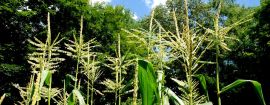 Every year the Environmental Working Group, as Washington-based organic lobbying group, publishes a list they call the Dirty Dozen, allegedly a list of fruits and vegetables with the highest residual pesticide concentrations. And every year the gullible mainstream press parrots their “findings” completely uncritically. Here’s the CNN report. You should note, however, that none of their board or staff has advanced degrees in science, with the exception of noted quack doctor Mark Hyman.
Every year the Environmental Working Group, as Washington-based organic lobbying group, publishes a list they call the Dirty Dozen, allegedly a list of fruits and vegetables with the highest residual pesticide concentrations. And every year the gullible mainstream press parrots their “findings” completely uncritically. Here’s the CNN report. You should note, however, that none of their board or staff has advanced degrees in science, with the exception of noted quack doctor Mark Hyman.
Here’s what the EWG’s crack staff actually does. They get the USDA’s annual Pesticide Data Program, and count pesticides per crop. Specifically they count
- Percent of samples tested with detectable pesticides
- Percent of samples with two or more detectable pesticides
- Average number of pesticides found on a single sample
- Average amount of pesticides found, measured in parts per million
- Maximum number of pesticides found on a single sample
- Total number of pesticides found on the commodity
The resulting numbers themselves do not appear anywhere on their web site however. But if you consider these counts with a critical eye, you will discover that nowhere do they compare the pesticide concentrations reported with known toxic levels for these compounds. In other words, these uncritical counts really don’t mean much.
This is not new news: it was reported in a well-regarded paper by Winter and Katz, published in the peer-reviewed Journal of Toxicology in 2011. They point out that the detection limits of modern analytical techniques are so sensitive that they can detect residues far below any concern for toxicity. In fact, for pesticides the EPA has developed a measure called the minimum reference dose (RfD) that is defined as
[A]n estimate, with uncertainty spanning perhaps an order of magnitude, of a daily oral exposure to the human population (including sensitive subgroups) that is likely to be without an appreciable risk of deleterious effects during a lifetime.
In other words, the RfD is the amount you could ingest daily for the rest of your life, without any ill effects. For example, for malathion, that dose is 20 ug/kg/day. So, for a 75 kg person (165 lb) they could ingest 1500 ug or 1.5 mg per day with complete safety.
So how much malathion did the EPA detect on strawberries which tops the EWG’s list? A range of .005 to 0.15 ppm. So for 100g of strawberries the maximum you might ingest is .015 mg, which is 100 times less than the reference dose of 1.5 mg.
This is typical of the misdirection of the EWG. They do everything to scare you but fail to note that the amount of pesticide detected is hundreds to thousands of times less than the safe dose determined by the EPA. Winter and Katz pointed all of this out five years ago.
In addition, Bruce Ames’ landmark paper in PNAS (Dietary Pesticides 99.99% all natural) showed that the pesticides that the plants manufacture on their own are 10,000 more concentrated than those residues. So this simply shows that the residues from farmer-applied pesticides are so small as to be insignificant, and that our food is safe, whether conventional or organic. Of course, the EWG suggests switching to organic because that is their bias, but both conventional and organic crops are sprayed, and some of the USDA organic approved chemicals are not that desirable either.
Finally, it is worth noting that the Environmental Working Group is not a practitioner of sound science. As Activist Facts notes, the EWG has been making wild, breathless claims for over 20 years, none supported by actual science, and simply to scare you away from “chemicals,” neglecting the fact that everything is made of chemicals. The EWG has taking anti-science positions against genetic engineering, and encouraged anti-vaccine hysteria. They are simply not credible, and you should disregard their crazed, but utterly mendacious claims.
This article was originally published on Examiner.com on May 6, 2016

I have seen that done. I have had poached eggs that were breaded and flash fried.
LikeLike